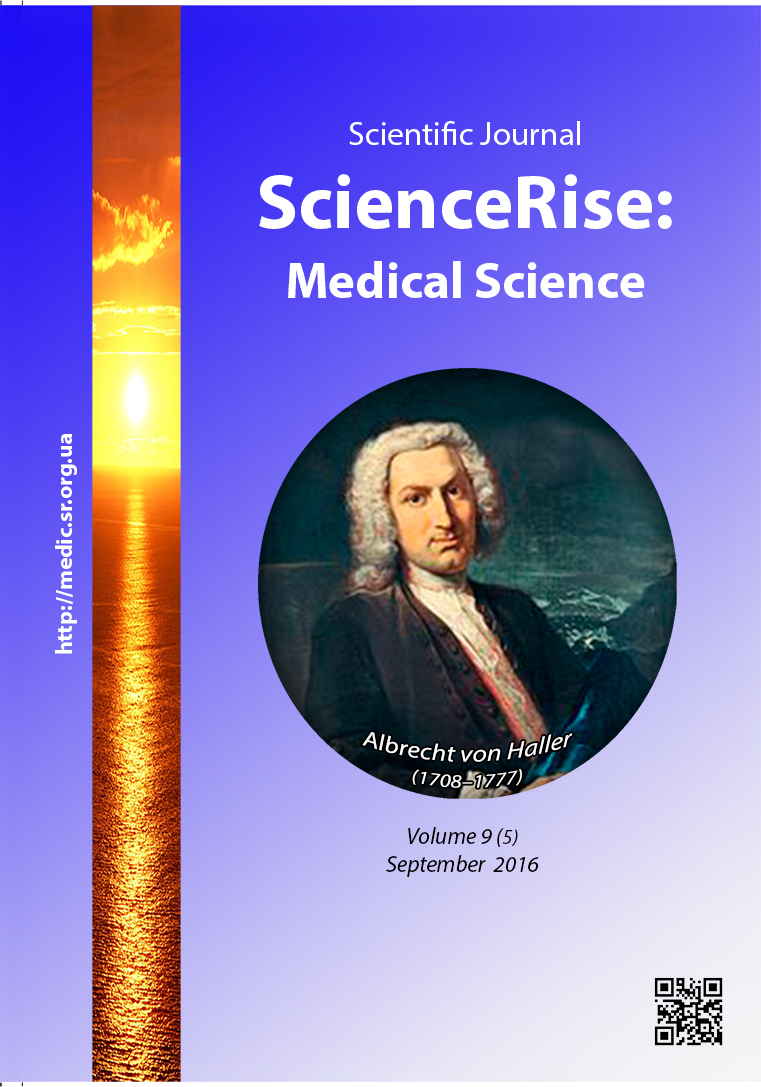Antioxidant therapy as a new method of prevention and treatment of heamatological toxicity of chemotherapy at breast cancer
DOI:
https://doi.org/10.15587/2519-4798.2016.77501Keywords:
breast cancer, antioxidant therapy, hematological toxicity, leucopenia preventionAbstract
The aim of our work was to study the effectiveness of antioxidant therapy in prevention and treatment of leucopenia; to investigate the influence of deficit of prooxidant system as to the risk of hematological disorders development (agranulocytosis development; to ground the necessity of application of antioxidant therapy for prevention and treatment of hematological toxicity of chemotherapy.
Materials and methods of research: retrospective study of medical documentation, biochemical analyzes, radiological examination. The control group included 110 persons, the group with studied preparation – 80 ones. All patients were women with spread breast cancer, who were treated by the standard chemotherapy schemes. The studied group received antioxidant Thiotriazoline during the treatment.
Results. In patients of the studied group, who received thiotriazoline in preventive and therapeutic regimes, the frequency of occurrence of leucopenia is reliably lower than in the control group of patients. Patients with the low level of SH-groups (less than 1 mmol/g of protein) at the parallel activation of oxidative stress are the group of neutropenia risk on the background of BC chemotherapy and need the dynamic observation with individual selection of thiol donors and preparations with verified antioxidant effect. The decrease of effectiveness of antioxidant enzymes of glutathione links and displacement of thiol-disulfide balance to the decrease of content of restored indicate the reliable clinical necessity of personal application of medical preparations with glutathione-protective effect and antioxidant potential such as Thiotriasoline, which clinical approbation was realized in our work
References
- Foote, M. A. (1998). The Importance of Planned Dose of Chemotherapy on Time: Do We Need to Change Our Clinical Practice? The Oncologist, 3 (5), 365–368.
- Crane, F. L., Low, H., Navas, P., Sun, I. L. (2013). Control of cell growth by plasma membrane NADH oxidation. Pacs, 1, 31–42. doi: 10.12988/pacs.2013.3310
- Pervin, S., Tran, L., Urman, R., Braga, M., Parveen, M., Li, S. A. et. al. (2013). Oxidative stress specifically downregulates survivin to promote breast tumour formation. British Journal of Cancer, 108 (4), 848–858. doi: 10.1038/bjc.2013.40
- Dayem, A. A., Choi, H.-Y., Kim, J.-H., Cho, S.-G. (2010). Role of Oxidative Stress in Stem, Cancer, and Cancer Stem Cells. Cancers, 2 (2), 859–884. doi: 10.3390/cancers2020859
- Antioxidant Supplementation During Cytotoxic Therapy (2008). JNCI J Natl Cancer Inst., 100 (11), 755.
- Sharifi, N. (2009). Commentary: Antioxidants for Cancer: New Tricks for an Old Dog? The Oncologist, 14 (3), 213–215. doi: 10.1634/theoncologist.2008-021
- Mahalingaiah, P. K. S., Singh, K. P. (2014). Chronic Oxidative Stress Increases Growth and Tumorigenic Potential of MCF-7 Breast Cancer Cells. PLoS ONE, 9 (1), e87371. doi: 10.1371/journal.pone.0087371
- Victorino, V., Pizzatti, L., Michelletti, P., Panis, C. (2014). Oxidative Stress, Redox Signaling and Cancer Chemoresistance: Putting Together the Pieces of the Puzzle. Current Medicinal Chemistry, 21 (28), 3211–3226. doi: 10.2174/0929867321666140601164647
- Marsh, C., Iveson, T., Milne, A. (2010). Adult neutropenic sepsis guidelines. Central South Coast. Cancernetwork, 1–17.
- Lundblad, R. L., Macdonald, F. (Eds.) (2010). Handbook of Biochemistry and Molecular Biology, Fourth Edition. CRC Press, 1098. doi: 10.1201/b11923
Downloads
Published
How to Cite
Issue
Section
License
Copyright (c) 2016 Анна Владимировна Прохач, Игорь Николаевич Бондаренко

This work is licensed under a Creative Commons Attribution 4.0 International License.
Our journal abides by the Creative Commons CC BY copyright rights and permissions for open access journals.
Authors, who are published in this journal, agree to the following conditions:
1. The authors reserve the right to authorship of the work and pass the first publication right of this work to the journal under the terms of a Creative Commons CC BY, which allows others to freely distribute the published research with the obligatory reference to the authors of the original work and the first publication of the work in this journal.
2. The authors have the right to conclude separate supplement agreements that relate to non-exclusive work distribution in the form in which it has been published by the journal (for example, to upload the work to the online storage of the journal or publish it as part of a monograph), provided that the reference to the first publication of the work in this journal is included.









